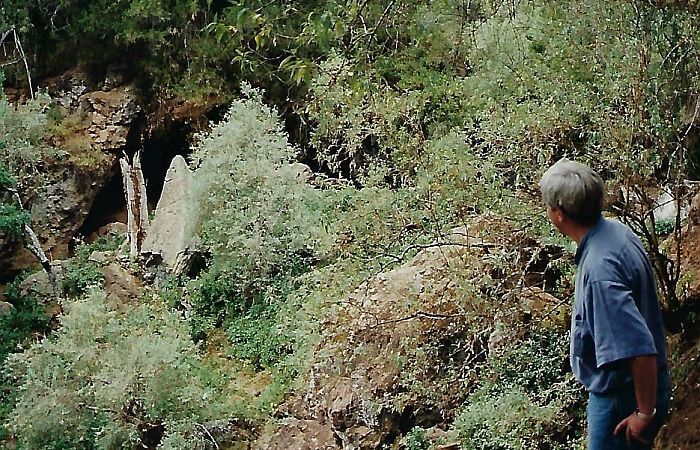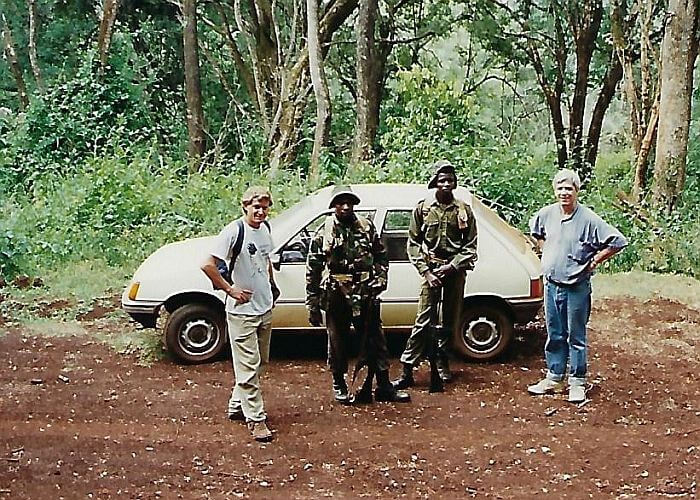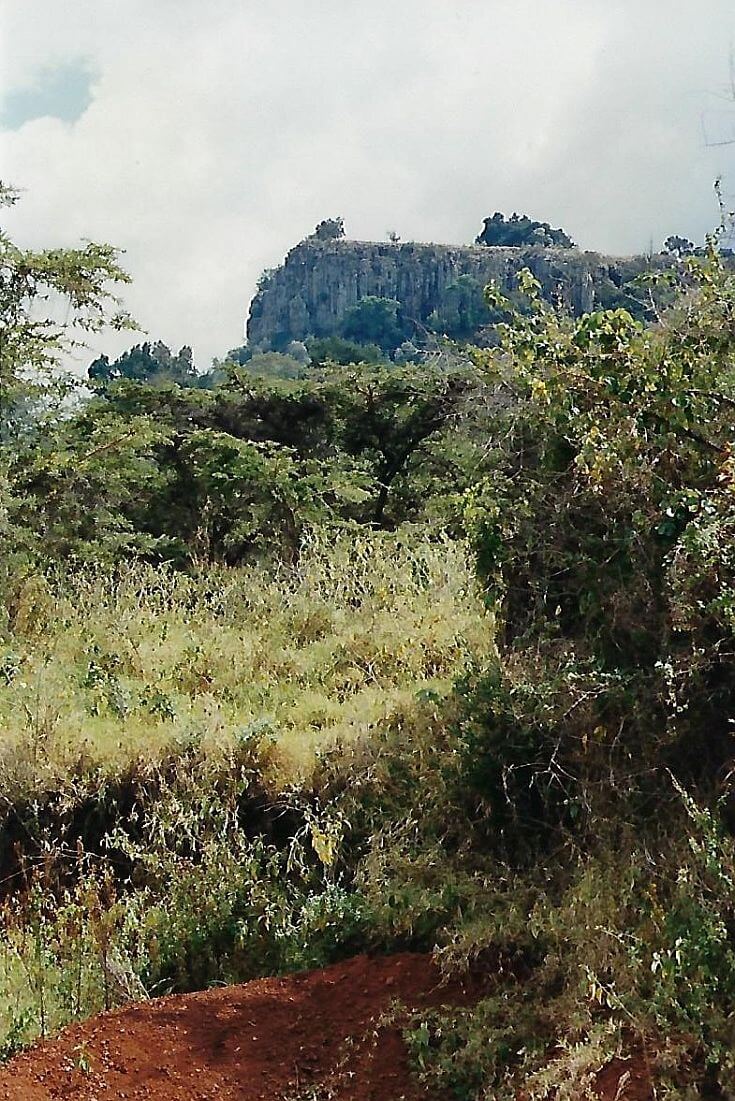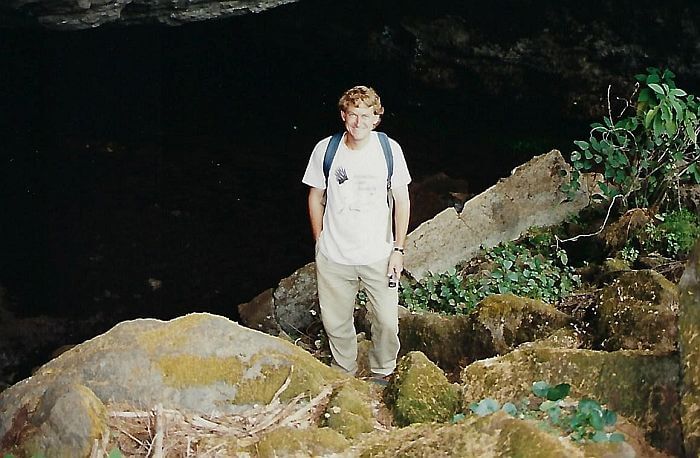Adventures in Kenya: Visiting the Hot Zone of Kitum Cave
Story and photos by Mark Aspelin
Near the Kenya-Uganda border lies the infamous Kitum Cave, home to bats, elephants, and perhaps a devastating virus.

"Gene felt a prickling sensation on his scalp. The paths of Charles Monet and Peter Cardinal had crossed at only one place on earth, and that was inside Kitum Cave. What had they done in the cave? What had they found in there? What had they touched? What had they breathed? What lived in Kitum Cave?" - Excerpt from the book The Hot Zone; The Terrifying True Story of the Origins of the Ebola Virus by Richard Preston
While I working as a conservation biologist in the western highlands of Kenya in the late '90s, one of the local members of the community suggested that I visit Kitum Cave, an interesting place where animals such as elephants "mine" salt from the walls of the cave by using their tusks to break off pieces of the cave and eat it. I'd never heard of the place, and it sounded pretty cool, so I said, "Sounds great—let's go!"
The next day, three of us drove towards the border of Uganda and entered Mount Elgon National Park, home of Kitum cave. One member of our group was a community leader responsible for managing a variety of crane and wetland conservation efforts in the community around Saiwa Swamp National Park.

The second was a local priest I had never met before. He had two PhDs, one in religion and one in ancient languages such as Sumerian and Aramaic. He also led efforts to bring clothes and other donated goods directly from Europe so that he could distribute them to people in need. This approach helped avoid the middleman, which often came in the form of corrupt government officials who required bribes or outright stole the donated items to sell. It was not uncommon to see donated good being sold on the streets for a profit rather than distributed to the intended communities in need.
The third member of the group was me, the clueless guy that didn't know what he was doing.
Upon entering Mount Elgon National Park, we were informed that we were not allowed to travel alone in the Park because of concerns about our safety due to wildlife. Instead, we were assigned not one, but two armed guards to pile into our small vehicle and escort us to the cave.
After a short, cramped drive, we parked at the Kitum Cave trailhead and were ready to begin our hike.
It was a relatively short walk with some nice scenery...and an occasional pile of elephant dung to add to the ambiance.
And as we rounded a corner, we finally spotted Kitum Cave.
First Tour Stop, a Deadly Virus Zone
 Little did I know at the time that Kitum Cave was infamous for reasons that would have prevented me from ever considering this trip. I learned later that it was believed to be a possible source of the Marburg Virus, a virus similar to Ebola. I consider that to be an important little nugget of information to have prior to considering a day trip to explore a cave!
Little did I know at the time that Kitum Cave was infamous for reasons that would have prevented me from ever considering this trip. I learned later that it was believed to be a possible source of the Marburg Virus, a virus similar to Ebola. I consider that to be an important little nugget of information to have prior to considering a day trip to explore a cave!
Apparently, two people had been killed by Marburg virus and the one thing that they both had in common was a visit to Kitum Cave. In 1980, a 56-year old Frenchman named Charles Monet explored the cave. Seven days later, the virus took its gruesome toll on him as the poor man bled out of all his orifices and died soon after entering a hospital in Nairobi.
Seven years later, a young Danish boy (named Peter Cardinal in Richard Preston's book, The Hot Zone) contracted Marburg after visiting Kitum Cave. He was eventually taken to Nairobi Hospital (the same hospital as Charles Monet) where the child died.
After the two deaths, a joint U.S. and Kenyan research investigation was formed in attempt to find Marburg Virus in Kitum Cave. The cave was closed to the public while researchers donned the highest level of protective gear as they scoured the cave walls, sampled bat and elephant poop, and captured a variety of bats, birds, and insects. According to locals that I later spoke with, they also kept cages with monkeys in the back of the cave to see if they would contract the virus. Despite these efforts, the team was not successful in locating the virus. So, a few years before my visit, the cave was opened back up to the public.
Instead of wearing a Biosafety Level 4 protective body suit and respirator, I entered the cave looking like this:

Hey, at least I had a flashlight.
The cave is about 700 feet deep into the side of Mount Elgon, and we proceeded to go deep enough into the cave, deep enough to require the use of our flashlights.
After about 30 minutes of exploring the cave, we climbed back in the car and ascended the road to an overlook on Mount Elgon where we could enjoy a nice view of Uganda.
The Hot Zone Connection
After our enjoyable day trip, I was dropped back off at my tent at Sirikwa Safaris. That is where things got a bit more interesting. The owner of Sirikwa Safaris, Jane Barnley, asked how the trip was and told me about a relatively new book published two years prior that I might be interested in since it mentions Kitum Cave. "Sounds interesting, what book is that?"

That's when Jane pulled a copy of The Hot Zone from her bookshelf, handed it to me, and proceeded to give me a quick overview of the key points—featuring gruesome deaths and the belief that Kitum cave was a possible source of the Ebola or Marburg virus.
"What?!" I was stunned. She then went on to explain that Peter Cardinal (the boy from the book) had started feeling sick on the very couch that we were standing next to before he was evacuated by helicopter.
I was a bit surprised to hear this news, putting it mildly, and was thinking to myself, "Why didn't anyone tell me this before the trip?" I retired to my tent and used a headlamp to stay up most of the night while I devoured the pages of the book.
Then things started to get even more interesting.

From the adapted miniseries on National Geographic Channel.
The Illness Begins
A few days later, I started feeling ill. Something was off. I was experiencing weird symptoms that included muscle spasms in my chest, near my heart, so that it looked like my skin was bubbling, but it was not in synch with my heartbeat. I was getting concerned, and my recent reading of The Hot Zone didn't put my mind at ease.
I decided to visit a local doctor who was originally from India but trained in England. He ran the most efficient urgent care clinic I have ever been to in my life. The staff included one person at the front desk and him. That's it. I walked in and explained my symptoms to the woman at the front desk while she jotted down some notes on a small piece of paper. The doctor entered the room, she handed him the slip of paper, and we stepped back into another room. The doctor asked more questions, drew some of my blood, put it on a slide, and looked at it under a microscope that he had in the back of the room.
He spun his chair around and told me that everything looked okay from the perspective of the normal cast of characters such as malaria and cholera. It was probably just a virus that I picked up from the local food or water. I paid cash at the front desk and that was it. A process that would have taken months in the U.S. for the doctor visit, lab work, lab results, claims submission, claims adjudication, and final payment had all been completed in about thirty minutes and cost me about $20.

Over the following week, my symptoms worsened though, and I ended up going to Nairobi National Hospital, the same place where Charles Monet and Peter Cardinal had been taken (and died). After more tests, the doctor couldn't figure out the cause, but he gave me a prescription that would help clear my body of any parasites to see if that would help. It didn't.
I eventually caught a flight to see a tropical medicine specialist in Cape Town, South Africa. By that time, the window for Marburg destruction had passed, so thankfully I could at least cross that option off the list. The doctor narrowed it down to a family of viruses that can cause muscle spasms of the intercostal muscles, among other symptoms. He said it wasn't worth spending more time and money to attempt to figure out which type of virus I had because there was nothing that could be done about it regardless.
In the end, I decided to return to the U.S. and recuperate at my parents' house in Colorado Springs. After about six months of clean living, while I worked temp jobs to pay the bills, I finally felt back to normal again.
Thankfully, I'm happy to report that I only have one thing in common with Charles Monet and Peter Cardinal: each of us visited Kitum Cave.
Mark Aspelin is a travel writer, author of two books (Profitable Conservation and How to Fail at Life: Lessons for the Next Generation) and two blogs (New Mexico and Beyond and Adventure-Spa.com). He has enjoyed a wide variety of adventures in his travels to 100 countries and all 50 U.S. States. Mark lives in the mountains outside of Albuquerque, New Mexico.
Related Features:
The Medicine Man in Benin - James Michael Dorsey
A Lion's Pride and the Will of the Tribe in Kenya - Luke Maguire Armstrong
A Quick trip to Hell in Ethiopia - James Michael Dorsey
Dance of Betrayal in Nairobi - Camille Cusumano
See other Africa travel stories from the archives
Copyright © Perceptive Travel 2019. All rights reserved.
- Sasabe and El Paso Border Towns: History, Street Art, and Tolerance by Sherry Shahan
- Living in the Moment Along the Kumano Kodo of Japan by Heidi Siefkas
- Cow Patties, Claws, and a Camel at a Mongolian Homestay by Julia Hubbel
- Travel Book Reviews by Susan Griffith
Books from the Author:

Buy Profitable Conservation at your local bookstore, or get it online here:
Amazon
Amazon UK

Buy How to Fail at Life: Lessons for the Next Generation at your local bookstore, or get it online here:
Amazon
Amazon UK

